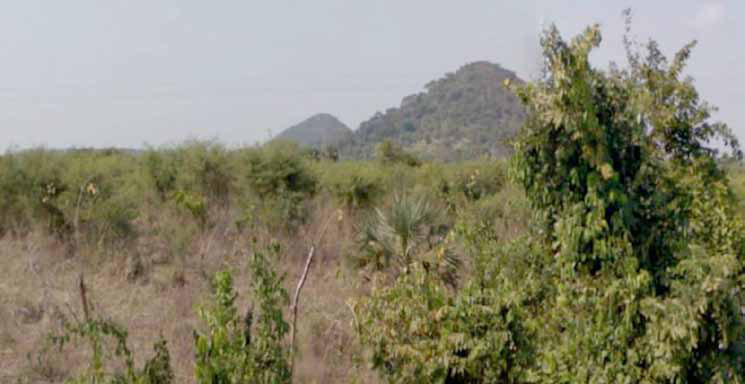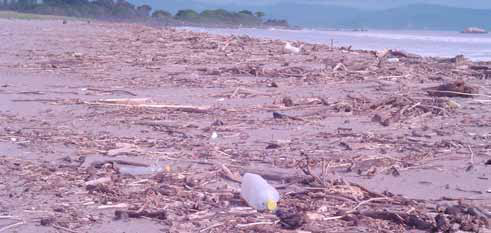 Chacalilla, in the county of San Blas, Nayarit, is known worldwide as an area for widespread arqueological artifacts. (Photo: Googlearth)
Chacalilla, in the county of San Blas, Nayarit, is known worldwide as an area for widespread arqueological artifacts. (Photo: Googlearth)On the outskirts of the community of Chacalilla, located to the north of Puerto San Blas, the technique of slash and burn is being used solely to unearth archaeological treasures that are then sold to foreigners without benefit of a professional evaluation of their historical worth.
All of this burning, cutting, and excavation is being done illegally within a radius of 6 miles to the west of Chacalilla and extends to neighboring communities like Las Palmas and Las Coloradas, although on a smaller scale.
“In the last 15 years wherever they had excavated, they found these pieces,” asserts a worker from around Chacalilla. “Now that all of the area has been dug up, the inhabitants are leaving, slashing, burning and excavating as they go, looking for more of these relics just so they can sell them to American tourists,” he added.
Mexican law considers these actions to be a squandering of the national heritage, not only because they are contraband articles with anthropological value, but also because of the destructive impact on Mexico’s heritage of native flora and fauna.
Investigators from the National Institute of Anthropology and History (INAH) and the University of California have conducted studies covering the period between 1960 and 1975, which reveal that Chacalilla was a waystation for the Mexicas as they left the island of Mexcaltitlán—near the coast of Nayarit—and headed toward La Gran Tenochtitlán , located in what is today the state of Mexico. Researchers discovered that they had built great ceremonial monuments dedicated to their deities where thousands of pieces of craftwork were left. With the passage of time, these characteristically unique Mexican artefacts were unearthed as the agricultural people of Chacalilla plowed their fields.
Since it is widely known that in Chacalilla one can find many types of vessels and other handiwork of great antiquity, people travel there in the guise of tourists, with their true goal being to buy these treasures.
This means that many local people go to the countryside looking for these precious objects, slashing and burning everything around them without a thought for the consequences.
“These same American tourists come to my ranch just to take home the pots that many people here sell,” revealed a student from Chacalilla.
Families with few resources can charge a measly 10 or 15 pesos apiece in an effort to support themselves.
This dynamic means a loss of raw material that could lead to a better understanding of the original people, the Mexicas. In addition, the law demands that archaeological treasures be protected as part of the national heritage.
And if this weren’t enough, Mexico’s world reknowned biodiversity is also being diminished. The effects of illegal slash and burn are felt as was well by the few remaining specimens of endangered species living in the area since these activities lead to loss of habitat and reproductive range.
Some of the species that are still able to find refuge in the municipality of San Blas are jaguars and other wild cats, raccoons, crocodiles, and a variety of birds.
 Chacalilla, in the county of San Blas, Nayarit, is known worldwide as an area for widespread arqueological artifacts. (Photo: Googlearth)
Chacalilla, in the county of San Blas, Nayarit, is known worldwide as an area for widespread arqueological artifacts. (Photo: Googlearth)The Port of San Blas, located in the state of Nayarit, is famous for its pleasant climate and clean beaches. But many don’t know that it’s not always in that condition.
Each year, during Easter week, the residents begin cleaning their houses, street and public places so that the San Blas beaches sparkle for the tourists.
But each year when the rainy season comes, the beaches are fouled by large quantities of water liles.
Even the residents have said that in 2010, the remains of this fresh water species that have washed up on the beaches has been excessive. “In previous years, the garbage was less than it is now.” commented a neighbor.
The lilies are washed onto the beaches from the fresh water lagoons located in the wetlands along the coast of Nayarit. The lagoons overflow their banks and flow to the sea during the rainy season. But that isn’t the only problem.
The lagoons are important to the healthy balance of the natural ecosystem and provide many ecological services to the resident population, such as drinking water. But when the water becomes contaminated, the lilies grow excessively.
So, when a community extracts water for its use from the lagoons, the workers cut the lily plants in order to open up room to do their work. It’s after that, when the rain falls, that the lagoons fill up and then spill over carrying these weeds away.
 Water lillies are a natural source of beach debris that has begun to wash ashore in alarming quantities. (Photo: Irvin Aguilar)
Water lillies are a natural source of beach debris that has begun to wash ashore in alarming quantities. (Photo: Irvin Aguilar)That is the story of the San Cristobal estuary. The majority of the communites north of San Blas, like Chiripa, Chacalilla and Guadalupe Victoria, obtain their drinking water from small rivers and lagoons that connect with the San Cristobal estuary through small channels of brackish or salt water.
When the lagoons overflow into the estuary’s channels, the trimmings from the water lily are also carried along. Water and vegetable matter are transported across the entire estuary system and flow out into the sea. The lily stems are then washed up onto the main beaches of San Blas, among these El Borrego and Las Islitas.
There among the tangle of vegetation, dangerous animals such as snakes and crocodiles (which do not belong in the coastal zone) hide or take refuge. Adding to this threat is all of the garbage both thrown out by people living along the coast and that washing ashore from the open ocean.
The situation is detrimental to the health and economy of the port to such a degree that some despair. Its so bad that residents and local fish vendors along the beaches have even returned to quoting the old refrain: “My San Blas isn’t like it was, it just keeps getting worse.”